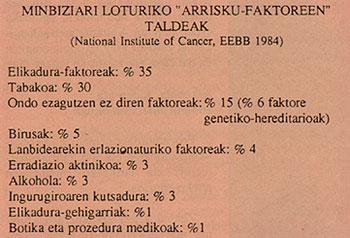Knowing the cancer. Feeding Factors in Cancer Epidemiology
1988/06/01 Karrera, Jesus Mari Iturria: Elhuyar aldizkaria
It is increasingly clear that the agents causing many malignant tumors are largely external factors. In 1984, for example, the National Cancer Institute of the United States, in the classification of risk factors related to cancer, attributed the highest percentages to those related to food. This institute distributed these risk factors by groups as follows:

However, these data cannot be taken in isolation. The new vision of the health society in recent years and the hope of prolonging life when analyzing the incidence of cancer are factors that have been taken into account, together with the previous ones.
However, at the state level it is true that in the last century mortality rates from malignant tumors are on the rise: at the beginning of the century death from cancer represented 1.3% of the total deaths, in 1950 16.9% and in 1979 19.6%.

By sex, mortality is increasing among men, with predominance of lung cancer and also among women, due to breast cancer.
As for the new annual cancers, the Cancer Registries indicate that there are still between 250 and 300 survivors in Spain.
We must first mention that in this exhibition it is not a question of instilling epidemiological analysis or analyzing its internal problems. In the different stages of cancer, we will only distinguish those elements of the diet that may influence in some way. However, it should be noted that the epidemiological method is a valid method for the study of long and degenerative diseases and that, on the other hand, these risk factors can be prevented collectively, that is, if one works in the field of public health.
Diet and fiber content
It seems that a higher consumption of vegetables and cereals reduces the risk of intestinal cancer. The reduction in risk is due to the increase in the volume of the feces and the increase in intestinal transit through these foods. At the same time, the possible carcinogens are dissolved and the ability to remove these carcinogens in the intestinal mucosa is reduced.
At this level, a series of studies and controls have been carried out, comparing the population that ingests different amounts of fibers in the usual diet. However, although there is a recognized relationship for the abundance of unquestionable points, the epidemiological data available today do not allow any person to be advised of a diet with high fiber content.

In a diet there may be many elements capable of causing cancer in different areas. Some are spontaneous carcinogens and others promote and intensify malignant cells. Below are some foods that can be harmful, but should only be taken as an example, since not all are included.
Fats Fat Fat Fat
Diets rich in fat and meat are the ones that most influenced bowel cancer. These foods form carcinogenic substances through the overformation of bile and sterol acids and bacterial activity (usually anaerobic). Fat has also been linked to prostate and breast cancer. However, it seems that they have more to do with polyunsaturated fats.
Vitamins and vegetables of the fox family
These foods prevent the formation of nitrosamines and reduce bacterial changes.
Analyzing some cases, these foods appear to have a protective effect on lung, larynx, bladder, mouth, cervix, bowel, and prostate cancers. But animal experiments also question whether excess vitamin A does not cause certain types of cancer.
Alcohol, coffee and synthetic sweeteners
The relationship between excessive alcohol consumption and cancer of the mouth, pharynx, esophagus, and larynx has been shown.
Some studies indicate that bladder cancer increases in the roughest cafes.

As for synthetic sweeteners, experiments with animals show that many of them occur if consumed. However, these results, for the moment, cannot overlap the man.
Other agents of the diet
Other agents may be important in the generation of cancer, but to confirm its direct influence it is necessary to perform more detailed studies. However, highlights include aflatoxin B, selenium and nitrates and nitrites used as preservatives.
The data obtained through epidemiology, therefore, are not necessarily absolute, and although they are of interest to public health, they are not obligatory.
Some recommendations against cancer
We can therefore conclude that there is currently no anticancer diet, but a set of recommendations applicable to this problem are:
- Reduce food rations with excess calories.
- Increase the consumption of foods rich in vegetable fibers.
- Reduce the consumption of fats and, above all, animal fats so that the fat intake does not exceed 25-30% of the total caloric intake.
- Frequent consumption of foods rich in vitamins A and C (fruit, vegetables, etc. ).
- Limit the consumption of smoked foods or many roasts. Do the same with the cured.
- Avoid over-cooked foods.
- Avoid excessively hot foods or drinks.
- Maintain a proper feeding rhythm: take care of meals.
- Maintenance of oral cleaning.
- Eradicate alcoholism and smoking.
Barriers to increase public health
Therefore, these measures would be similar to those that should be taken to strengthen public health as a result of epidemiological studies, but we often consider them inapplicable. Why? In this sense, we will cite the following problems:
- Absence of diets against cancer.
- Disproportion between food production and the world population. Economic delay.
- Problems in the production of food.
- Difficulties to change the eating habits of society.
- Importance of health education in food and maintenance.
Therefore, any program aimed at promoting public health should have at least three pillars of support: epidemiological research, basic biochemical cancer research, and clinical studies.

Gai honi buruzko eduki gehiago
Elhuyarrek garatutako teknologia




